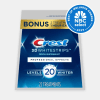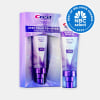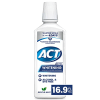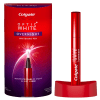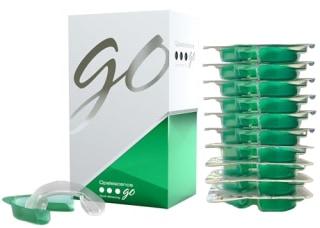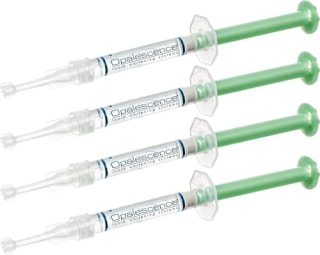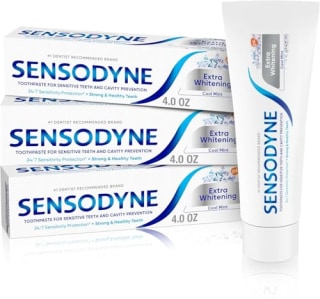Regardless of how much you want a brighter smile, you may be resistant to book a professional whitening treatment at your dentist’s office. It’s the fastest and most effective way to see results, but it’s costly and time consuming. If you’re leaning toward an at-home whitening treatment, there’s no shortage of options available, like strips, gels, toothpastes and mouthwashes. But do they really work?
To find out, I talked to dentists, who broke down everything you need to know about whitening your teeth at home, including when (and if) you’ll see a visible difference in tooth color. Using their guidance, I rounded up the best at-home teeth whitening products to buy, many of which the NBC Select staff tested.
SKIP AHEAD How I picked the best at-home whitening products | The best teeth whitening products of 2025 | Why trust NBC Select?
Want more from NBC Select? Sign up for our newsletter, The Selection, and shop smarter.
How I picked the best at-home teeth whitening products
Experts recommend considering the following factors while shopping for at-home teeth whitening products:
- Active ingredients: Hydrogen and carbamide peroxide are the two most common whitening agents in dental care products, according to the American Dental Association. The active ingredients penetrate tooth enamel and break down discoloration without softening or thinning teeth, experts say.
- Strength: The more concentrated active whitening ingredients are, the stronger and more effective the product is. But the most powerful whitener may not be the best option for you, says Dr. Matt Messina, an assistant professor at The Ohio State University College of Dentistry. If you’ve never whitened your teeth before or have a history of tooth sensitivity, start with products that have a low concentration of active ingredients and gradually increase if you can tolerate it, he says.
- Product type: At-home teeth whitening products are available as toothpastes, whitening pens, whitening trays, mouthwashes and more. Think about which you prefer and which best fits into your lifestyle. Teeth whitening products only work if you use them consistently, so choose a product you’ll stick with.
- ADA Seal of Acceptance: The ADA Seal of Acceptance is the gold standard for dental care products. Brands can voluntarily submit data for the ADA to review, and if the organization deems the product safe and effective according to specific criteria, it earns the seal. This doesn’t mean that whitening products without the seal are ineffective — it just means brands haven’t submitted their products for the ADA to review.
The best at-home teeth whitening products of 2025
To recommend the best at-home teeth whitening products, I rounded up options that meet expert guidance. I included options with the ADA Seal of Acceptance, those NBC Select staff members have tested, NBC Select Wellness Award Winners and other highly rated treatments.
Teeth whitening strips and trays
Whitening strips are essentially stickers for your upper and lower teeth that are coated with a thin layer of an active bleaching ingredient, like hydrogen peroxide. As the strips sit on your teeth, the ingredients penetrate enamel to brighten it. Whitening trays work similarly to strips, but you bite into them rather than adhere them to the front of teeth. Most trays come prefilled with whitening gel — if not, you’ll need to fill them with gel before a treatment.
While shopping you may see strips and trays that come with an LED light, which many brands advertise as being able to enhance or accelerate the whitening process. However, the dentists I talked to do not recommend using them. “Not all LED lights are created equal, and the ones included in at-home whitening kits are significantly weaker than those used in professional treatments,” says Dr. Erin Fraundorf, a dentist at Boca Orthodontic and Whitening Studio. “Whether or not you use an LED light with your at-home whitening kit, your results will be the same.”
Crest 3D Whitestrips Professional Effects
- ADA-approved
- Non-slip grip
- Flexible yet sturdy
- Longer application time
Crest makes some of the only ADA-approved whitening strips, which is one of many reasons why they’re beloved among our team. The strips are coated in hydrogen peroxide gel and have a non-slip grip, which helps them stay put during treatments. They’re flexible, so I can bend them around the curve of my teeth, but they’re sturdy enough that they don’t roll in on themselves when I take them off the packaging. Crest’s strips are also quite thin, so I barely feel them and can talk normally during a treatment. This box comes with enough strips for 20 45-minute treatments and two 1-hour express treatments.
Opalescence Go Teeth Whitening Trays
- Easy-to-apply trays
- Molds to shape of teeth
- Minty flavor
- Too concentrated for some
NBC Select editor Lindsay Schneider finds Opalescence’s whitening trays easier to apply than whitening strips — you bite into them and they mold around the shape of your teeth. “They’re so easy to pop on and off, and I find them comfortable to wear for longer periods of time,” says Schneider. Her dentist recommended these trays, which you leave on for about 30 minutes, because they’re made with a professional-grade, 10% hydrogen peroxide, minty gel. “I definitely see a difference when using these consistently — my teeth are noticeably whiter,” says Schneider. “Because they’re stronger, my teeth get a little sensitive when using them, but that’s the case with almost all whitening products for me.”
Opalescence Teeth Whitening Gel Syringes
- Professional-grade
- Syringe dispenser
- Many flavors available
- Custom trays required for use
- May need long application time
Over-the-counter whitening trays are one size fits all, which not everyone finds comfortable or effective. Instead, your dentist can make you custom trays that fit the exact shape of your mouth, and you can buy whitening gel to fill them with. “Using custom whitening trays made by your dentist can isolate where the whitening material goes,” says Fraundorf. “You can better control it to prevent it from touching your gum tissue.”
Opalescence’s whitening gel is professional-grade like its trays. Its main active ingredient is carbamide peroxide, and there’s also hydrogen peroxide in its formula. The gel is available in four concentrations, 10%, 15%, 20% and 35%, each of which has a different treatment time ranging from 30 minutes to overnight. It comes in syringes with a narrow nozzle, helping you fill your trays without causing them to overflow. The gel is available in mint and melon flavors, as well as an unflavored option.
Teeth whitening toothpaste
Whitening toothpaste primarily relies on abrasives to remove surface stains from teeth, according to the ADA. All toothpaste is mildly abrasive to scrub teeth clean, but whitening toothpaste has ingredients that specifically target surface stains, like sodium bicarbonate (baking soda). Whitening toothpaste has a low concentration of active ingredients, making it a great option to start with if you’ve never used other teeth whitening products. It works best for surface stains and maintenance after you’ve used another form of whitening, says Messina.
Crest 3D White Brilliance Deep Stain Remover Ultra White Toothpaste
- Works quickly
- Pump dispenser
- Anti-cavity
- Subtle flavor
Every member of our team who tested this toothpaste had the same review: it’s shockingly effective. “My coffee-stained teeth started visibly whitening in just days — so much so, my dentist thought I’d gotten a professional treatment,” says NBC Select editorial director Lauren Swanson. “Crest Deep Stain Remover is now my go-to, and yes, I’m buying a lifetime supply, and one for my grandma, too.” The minty toothpaste is made with hydrated silica, which dissolves the bonds that adhere stains to teeth and scrubs them off the surface, according to the brand. There’s also fluoride in its formula to protect teeth from cavities and repair enamel. The toothpaste comes in a pump dispenser, which prevents you from using too much at a time.
Sensodyne Extra Whitening Toothpaste
- Soothes sensitive teeth
- Whitens without irritation
- Anti-cavity
- Subtle flavor
Sensodyne makes some of our favorite toothpastes for sensitive teeth, and this option offers additional whitening benefits. Its formula has hydrated silica to buff stains away, as well as potassium nitrate to soothe nerves for up to 24 hours, according to the brand. The toothpaste also has fluoride in it to fight cavities. “I’ve always had really sensitive teeth, especially to cold, and I’m always nervous to do whitening treatments,” says NBC senior community manager Rosalie Sparaco. “Having a toothpaste that can help my teeth feel less sensitive to cold drinks while whitening is a win-win.”
Best whitening mouthwash
Like whitening toothpaste, whitening mouthwash has a low concentration of active ingredients, so its impact is minimal. That said, whitening mouthwash is a good option to use after a professional whitening treatment or if you’ve never whitened your teeth at home before.
Act Whitening + Anticavity Fluoride Mouthwash
- Free from alcohol and dyes
- Freshens breath
- Anti-cavity
- Nothing to note at this time
ACT’s Whitening + Anticavity mouthwash uses hydrogen peroxide to brighten your teeth and fluoride to prevent cavities. It’s free-from alcohol and dyes, according to the brand, and has a mint flavor to freshen breath.
Best teeth whitening pens
Whitening pens help you brighten teeth quickly and while on the go. They’re filled with a gel made from hydrogen or carbamide peroxide, which you brush on your teeth and leave on for a specified period of time. Similar to whitening toothpaste and mouthwash, it’s best to use these pens as a maintenance tool after a stronger treatment.
Colgate Optic White Overnight Teeth Whitening Pen
- Precision brush
- Easy to travel with
- Quick-dry gel
- Best for overnight use
Colgate’s whitening pen is filled with hydrogen peroxide gel, and its overall construction resembles lipstick. You unscrew the attached brush, dip it into the gel and apply it on your teeth. The brush is very small, so you can coat one tooth at a time and make sure you don’t miss a spot. The brand recommends applying the quick-dry gel before bed, leaving it on your teeth overnight and brushing it off in the morning.
Meet our experts
At NBC Select, we work with experts who have specialized knowledge and authority based on relevant training and/or experience. We also take steps to ensure that all expert advice and recommendations are made independently and with no undisclosed financial conflicts of interest.
- Dr. Matt Messina is an assistant professor at The Ohio State University College of Dentistry and the clinic director of Ohio State’s Upper Arlington Dentistry.
- Dr. Ilona Casellini is the founder of and a dentist at Swiss Quality Smile.
- Dr. Erin Fraundorf is a dentist at Boca Orthodontic and Whitening Studio.
Why trust NBC Select?
I’m a reporter at NBC Select who has written about dental care for five years, including stories on electric toothbrushes, toothpaste, whitening toothpaste, kid’s toothpaste, floss and water flossers. For this article, I interviewed three experts about how to shop for at-home teeth whitening treatments. To recommend the best whitening treatments, I rounded up options that align with dentists’ guidance, including products the NBC Select staff tested.
Catch up on NBC Select’s in-depth coverage of tech and tools, wellness and more, and follow us on Facebook, Instagram, Twitter and TikTok to stay up to date.

